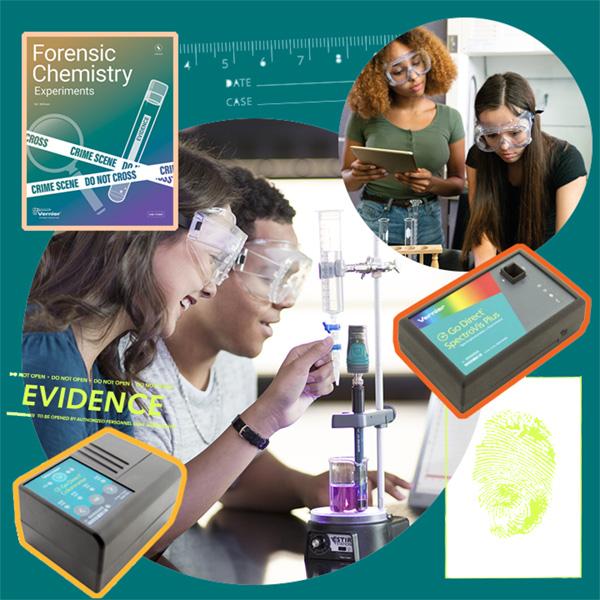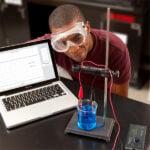
Sharing ideas and inspiration for engagement, inclusion, and excellence in STEM

Looking for a way to make chemistry class more exciting for your students? One approach is to use fictitious crimes to provide real-world learning opportunities at the crossroads of chemistry fundamentals and crime scene analysis.
With our newest lab book, Forensic Chemistry Experiments, educators can teach students fundamental chemistry concepts through engaging forensic investigations. This lab book features 15 experiments specifically designed for introductory and advanced high school and college-level chemistry classes. Through hands-on experimentation using Vernier data-collection technology, students experience the excitement of solving crimes while deepening their understanding of key chemistry concepts.
Hands-on learning opportunities include
- Use gas laws to determine how the relationships of pressure, volume, temperature, and number of molecules of a gas can help solve cases involved with gases.
- Use absorbance, emission, and fluorescence spectroscopy to determine the contaminants in drinks and determine secret messages written with invisible inks.
- Use conductivity and pH to compare the compounds in aqueous solutions for different water sources and mystery powders.
- Apply the principles of thermochemistry and calorimetry to determine the heat of combustion of accelerants and the heat of solution of sweeteners.
These experiments provide a fun twist on learning key chemistry concepts. For instance, students can use spectroscopy to “solve” a case of a poisoned drink and explore intermolecular forces while investigating an imagined arson.
Start Your Investigations with a Free Experiment
Ready to try out a forensics lesson in your classroom? Get started with one of our favorite experiments!

Download “Avogadro’s Law and Order: Investigating a Rocket Launch Failure.”
In this experiment, students investigate the details of a bottle rocket mishap to gain insights into the connection between gas pressure, the quantity of molecules within a confined space at a consistent temperature, and the significance of gas composition.
Sensors and Equipment
- Go Direct® Gas Pressure Sensor
- Go Direct Temperature Probe
- Stir Station
- Vernier Graphical Analysis® Pro
Experiment Objectives
- Use a scale model to investigate the changes in gas pressure as fixed volumes of gas are added.
- Analyze data to develop a mathematical model that can predict the volume of gas needed to reach the pressure limit of a 2 L bottle.
- Use mathematical representations to compare the rates of change in pressure for air and carbon dioxide as fixed volumes of gas are added.
- Communicate scientific and technical information and ideas about how to determine the cause of the 2 L bottle explosion.
Looking for even more ways to get comfortable teaching forensic chemistry? Check out our webinar “Chemical Clues: A Titrating Tale of Makeup Remove Contamination” where our chemistry experts will walk you through an acid-base titration that involves the use of the Go Direct® pH Sensor and Go Direct Drop Counter. Students also learn about equations and stoichiometry.
Are you looking to incorporate forensic experiments into your chemistry class? We’d love to discuss options and brainstorm ideas! Contact us at chemistry@vernier.com or 888-837-6437.
Share this Article

Sign up for our newsletter
Stay in the loop! Beyond Measure delivers monthly updates on the latest news, ideas, and STEM resources from Vernier.






